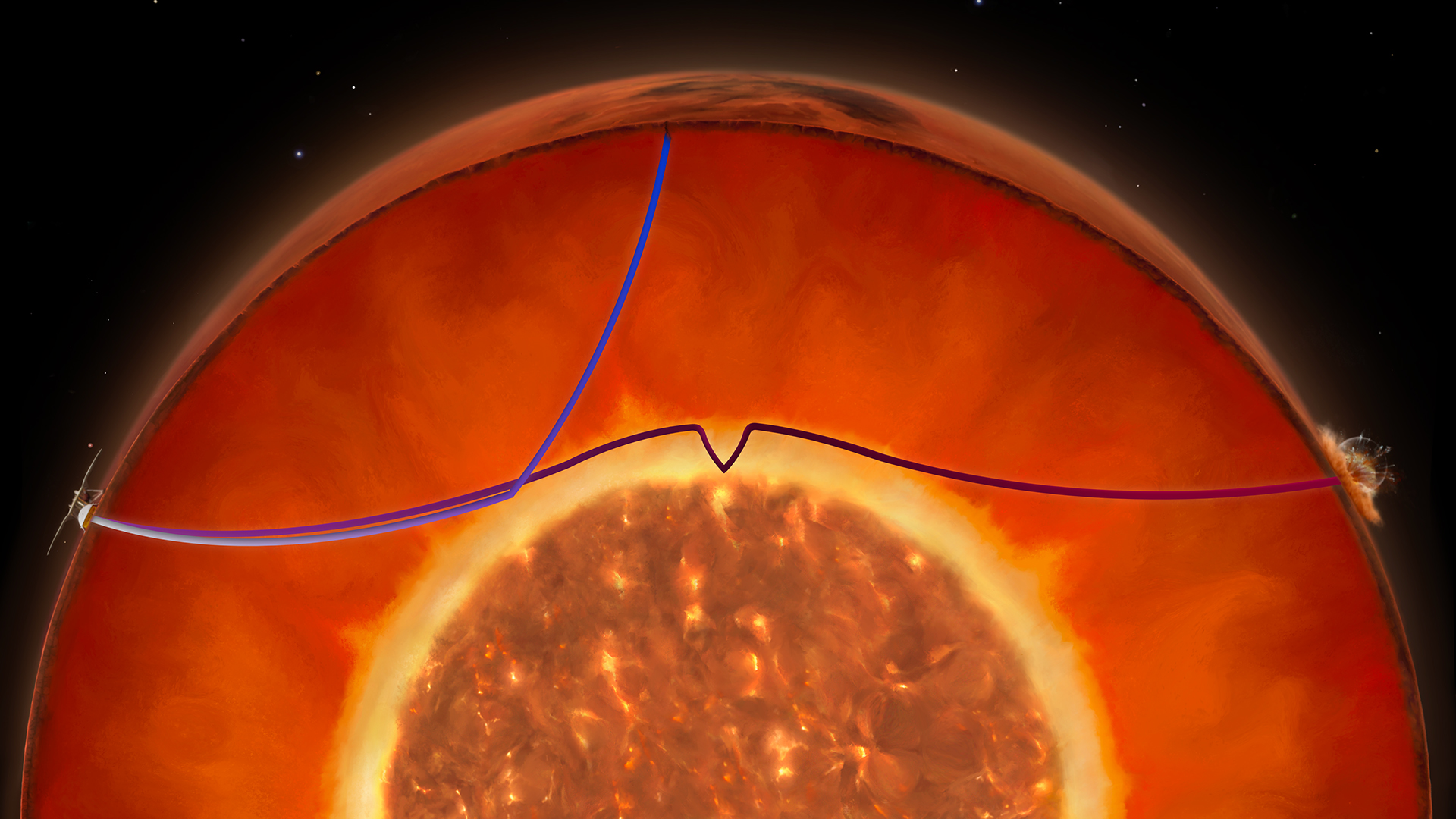The analysis by the InSight mission science team of seismic data recorded on Mars following a meteorite impact that occurred in September 2021 drastically changes our vision of the internal structure of the Red Planet and its evolution. A study published on October 26 in the journal Nature and involving French scientists from CNRS, IPGP, ISAE-SUPAERO and Université Paris Cité, proposes a new model for the interior of Mars, with a heterogeneous mantle composed of a molten silicate layer overlying the Martian core, and explains all available geophysical observations.

© IPGP – CNES – N. Sarter
The first data from the InSight mission made it possible to determine the internal structure of Mars in a series of papers from the scientific team published in the summer of 2021. However, since then, the analysis of new data generated by a powerful meteorite impact that occurred on September 18 2021, questioned the first estimates of the internal structure of the Red Planet. By studying the propagation times of waves generated by this impact, an international team led by Henri Samuel, CNRS researcher at the Institut de Pysique duGlobe de Paris, and involving scientists from CNRS, ISAE-SUPAERO and Université Paris Cité supported by CNES and ANR, as well as co-authors from the Royal Observatory of Belgium, the Universities of Maryland and Bristol, the Zürich Polytechnic School, the Russian Academy of Sciences, and NASA’s Jet Propulsion Laboratory, demonstrated the presence of a molten silicate layer at the base of the Martian mantle overlying the metallic core.
This new structure model, published on October 26, 2023 in the journal Nature, is not only more consistent realistic with all available the geophysical data, but also explains better the evolution of Mars since its formation.
In particular, the evidence of this stratification of the Martian mantle elucidates the abnormally slow propagation, hitherto unexplained, of diffracted waves from the September 2021 meteorite impact by their trajectory in the lower and fully molten part of the basal layer, where seismic velocities are low. Furthermore, for several older seismic events, the arrival times of waves measured at the surface of Mars are compatible with reflections of shear waves at the top of the molten layer (located several tens of kilometers above the metallic core) and not at the core-mantle interface, as previously assumed. Finally, the presence of this basal layer helps explain the observed trajectory of Phobos, Mars’s closest moon. Indeed, the upper and partially molten part of the basal layer efficiently dissipates the deformations generated by Phobos’s gravitational attraction. In contrast, the solid mantle above this layer is more rigid and seismically poorly attenuating, as suggested by the detection at the surface of Mars of waves associated with seismic events of relatively low magnitude.
A smaller, denser core than envisaged
The presence of this molten layer at the base of the mantle implies a metallic core 150 to 170 km smaller (i.e., a radius of 1650±20 km) and 5 to 8% denser (i.e., 6.5 g/cm3) than previous seismic estimates. This denser core would therefore be composed of an alloy with fewer light elements than previously required, and more compatible with cosmochemical data from the analysis of Martian meteorites and high-pressure experiments. The authors of the study therefore propose that Mars probably experienced an early magma ocean stage whose crystallization produced a stable layer at the base of the mantle, highly enriched in iron and radioactive elements. The heat released by the latter generated a basal layer of molten silicates located above the core, overlain by a thinner partially molten layer.
The study further states that such stratification of the mantle insulates the metal core, thereby preventing it from cooling and generating a thermal dynamo. “The thermal blanketing of Mars’s metallic core by the liquid layer at the base of the mantle implies that external sources are necessary to generate the magnetic field recorded in the Martian crust during the first 500-800 million years of its evolution. These sources could be energetic impacts, or core motion generated by gravitational interactions with ancient satellites which have since then disappeared”, explains Henri Samuel.
This stratified structure of the interior of the mantle of Mars, which contrasts with that of the Earth indicates different internal evolution of these two planets. Mélanie Drilleau, research engineer at ISAE-SUPAERO and co-author of the study, explains that “the discovery of this stratification in the Martian mantle opens new research horizons, since the seismic data recorded by the SEIS instrument of the InSight mission will now be reconsidered in the light of this new paradigm.”
References:
> Geophysical evidence for an enriched molten silicate layer above Mars’ core, H. Samuel, M. Drilleau, A. Rivoldini, Z. Xu, Q. Huang, R. F. Garcia, V. Lekic, J.C.E Irving, J. Badro, P. H. Lognonné, J. A. D. Connolly, T. Kawamura, T. Gudkova and W. B. Banerdt, Nature.
DOI : 10.1038/s41586-023-06601-8
About InSight and SEIS:
NASA’s InSight mission officially ended in December 2022 after more than four years of collecting unique science data on Mars.
JPL managed the InSight mission on behalf of NASA’s Science Mission Directorate. InSight is part of NASA’s Discovery program, managed by the Marshall Space Flight Center (MSFC), NASA’s Huntsville, Alabama facility. Lockheed Martin Space in Denver built the InSight probe, including its cruise stage and lander, and supported operation of the spacecraft for the mission. CNES was the prime contractor for SEIS and the Paris Institute of Globe Physics (Université Paris Cité/IPGP/CNRS) assumed scientific responsibility. CNES finances the French contributions, coordinates the international consortium (*) and was responsible for the integration, testing and supply of the complete instrument to NASA. IPGP designed the VBB (Very Broad Band) sensors, tested them before their delivery to CNES and contributes to the operation of VBBs on Mars.
The SEIS and APSS operations were carried out by CNES within FOCSE-SISMOC, with the support of the Centro de Astrobiologia (Spain). SEIS data are formatted and distributed by the Mars SEIS Data Service of IPG Paris, as part of the National Observation Service InSight to which LPG also contributes and, for Seismo activities at the School, GéoAzur. Daily identification of earthquakes was carried out by InSight’s Mars Quake Service, a collaborative operational service led by ETH Zurich to which seismologists from IPG Paris, the University of Bristol (UK) and Imperial College London ( UK).
Several other CNRS laboratories including LMD (CNRS/ENS Paris/Ecole polytechnique/Sorbonne University), LPG (CNRS/Nantes University/Le Mans University/University of Angers), IRAP (CNRS/University of Toulouse/CNES ), the LGL-TPE (CNRS/Ecole Normale Supérieure de Lyon/Claude Bernard University Lyon 1), the IMPMC (Sorbonne University/National Museum of Natural History/CNRS) and LAGRANGE (CNRS/Université Côte d’Azur/Observatoire of the Côte d’Azur) are participating with the IPGP and ISAE-SUPAERO in the analysis of data from the InSight mission. These analyzes are supported by CNES and the National Research Agency as part of the ANR MArs Geophysical InSight (MAGIS) project.
(*) in collaboration with SODERN for the production of the VBB, the JPL, the Swiss Federal Institute of Technology in Zurich (ETH, Zurich Switzerland), the Max Planck Institute for Solar System Research (MPS, Göttingen, Germany), the Imperial College London and the University of Oxford provided the SEIS subsystems and are involved in the scientific exploitation of SEIS.
Read more

Une mère sur quatre concernée par des soins irrespectueux en maternité
S’appuyant sur l’Enquête nationale périnatale de 2021, une équipe de chercheuses associant notamment l'Université Paris Cité révèle qu’un quart des mères en France seraient concernées par des soins irrespectueux en maternité, associés à un risque accru de dépression...
read more
Parcoursup : trouver nos formations
Université Paris Cité propose une variété de formations en phase avec les métiers d’aujourd’hui et de demain : 81 licences, 42 licences professionnelles, 23 double licences, 1 cursus d’ingénieur, 7 B.U.T, 260 masters et 21 écoles doctorales. Université Paris Cité...
read more
Meet-Up 2025 : plus de 100 participants réunis pour les sessions d’information organisées par l’Université Paris Cité sur les appels européens MSCA Postdoctoral Fellowships
Afin d'offrir aux post doctorantes, aux post doctorants et à leurs superviseurs le meilleur soutien possible pour une candidature réussie et de grande qualité aux appels MSCA Postdoctoral Fellowships (MSCA PF), le Réseau Recherche Europe, coordonné par l’Université...
read more
Deux projets d’excellence d’UPCité lauréats des ERC Consolidator Grants en mathématiques et neurosciences
Le Conseil européen de la recherche (ERC) a annoncé le 9 décembre 2025 les résultats de son appel à projets Consolidator Grants. Parmi les 25 lauréats français, deux projets sont coordonnés à l'Université Paris Cité : le projet SAMPLING porté par Laura Dugué,...
read more